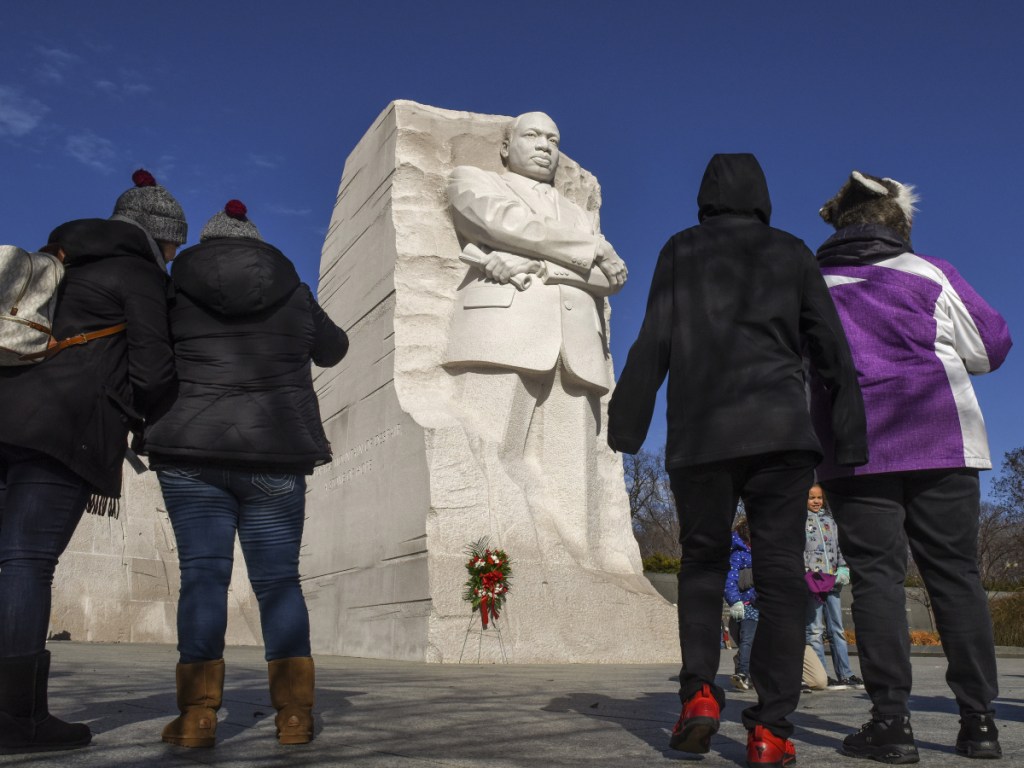WASHINGTON — The day the Rev. Martin Luther King Jr. was assassinated nearly 50 years ago, Loria Logan had just started grade school and was riding her bicycle outside her home in Chicago. Her mother called her inside with a sense of urgency in her voice.
In the living room, her mother had placed four chairs in front of the black-and-white television for herself and Logan’s father, grandmother and Logan.
“I remember the tears flowing from their faces. I didn’t understand what was happening until my grandmother turned to me and told me, ‘He was the greatest. Pay attention to the television,'” said Logan, now 56, a nurse who was visiting the Martin Luther King Jr. Memorial in Washington on Saturday from Chicago. “I’ll never forget it, the day he died.”
“To be here,” at the monument, she said, “is like a dream.”
But now, she said, progress made in race relations since King’s assassination in 1968 seems to be unraveling.
“At one point, we had reached really far,” Logan said. “By ’72, we were all one … But now, we are going back to where it used to be, with the racist comments, the violence.”
Logan turned to look up at the massive pink granite monument carved with the inscription: “Out of the mountain of despair, a stone of hope,” a line from King’s “I Have A Dream” speech given during the 1963 March on Washington for Jobs and Freedom.
As wind whipped across the frozen Tidal Basin, parents explained King’s legacy to their children. Two black boys in black hooded jackets stood in the shadow of the statue, holding clipboards and dutifully taking notes for a school assignment. Somebody had placed a funeral bouquet with red roses, red carnations and red ribbons against the base of the 30-foot memorial.
The memorial, which was carved by Chinese master sculptor Lei Yixin and dedicated in 2011, was the first on the Mall to honor an African-American man. The structure, intended to project King’s message of nonviolent, passive resistance to oppression, was designed to allow people to enter the plaza through a “mountain of despair.”
At the entrance to the memorial, two huge granite stones split, symbolizing that “mountain.” A slice of the sculpture is pushed out several feet from the split, and from this slice, King’s image emerges, carved into a “stone of hope,” a second massive piece of granite.
Some visitors recalled the optimism about race relations when the monument was unveiled. But now, they said, the country seems stuck in a dark period of racial tensions and open hostility toward new immigrants, shocked by Ku Klux Klan rallies and a president who referred last week to El Salvador, Haiti and African nations as “shithole countries.” The progress in the country’s race relations since King was assassinated that April day in Memphis seems to have become twisted, stuck in a time warp.
Toya Matthews, an assistant schools superintendent from Clarksdale, Mississippi, walked with her 15-year-old daughter, Taylor, near the south wall of the memorial. They snapped photos of the inscription, “Darkness cannot drive out darkness, only light can do that. Hate cannot drive out hate, only love can do that,” a quote from King’s book, “Strength to Love,” a collection of sermons published in 1963.
“I’m just looking at the news every day. It’s like you don’t want to think his work is in vain,” said Matthews, 42, who grew up in Mississippi, not far from where civil rights leader Medgar Evers was assassinated in 1963 by a Klansman hiding in bushes across the street from Evers’s home.
“But it’s unfortunate, we are still having conversations today about race,” Matthews said. “America is supposed to be a welcoming place for anybody coming to find the ‘American Dream,’ to live a better life.”
Matthews said that when she heard of President Trump’s remark maligning the countries of black and brown people, “I thought it was sad. All of us are descendants of people not born here. If you are not outraged by that statement, it says a lot about you. The Statue of Liberty says, ‘Give us your tired, your poor.’ It’s on there, but I don’t think we live by it today.”
To the right of the walkway of “Despair” stood Brian Curd, 33, visiting from Los Angeles. He read the quote carved in the memorial’s North Wall: “The ultimate measure of a man is not where he stands in moments of convenience and comfort, but where he stands at times of challenge and controversy.”
He stepped back, looked up and read the quote again.
“There’s a lot of discord right now,” said Curd, a mechanical engineer. “We are fractured. Civility has been lost. As a society, we have two halves – two countries right now.”
Curd recalled the August rally in Charlottesville, Virginia, where Heather Heyer, a 32-year-old antiracism activist, was killed when a car ran into a crowd of counterprotesters. A self-professed neo-Nazi has been charged in the incident.
“Charlottesville was very ugly,” Curd said, “very disappointing, especially with the death of that woman. People have a right to assemble, even if what they say is disgusting. It might still be awhile before things change for the better, but I’m hopeful.” I think we will make it through this rough patch.”
Send questions/comments to the editors.



Success. Please wait for the page to reload. If the page does not reload within 5 seconds, please refresh the page.
Enter your email and password to access comments.
Hi, to comment on stories you must . This profile is in addition to your subscription and website login.
Already have a commenting profile? .
Invalid username/password.
Please check your email to confirm and complete your registration.
Only subscribers are eligible to post comments. Please subscribe or login first for digital access. Here’s why.
Use the form below to reset your password. When you've submitted your account email, we will send an email with a reset code.